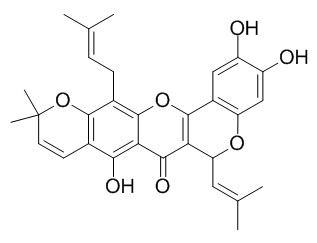Cycloheterophyllin
Cycloheterophyllin has an antioxidant effect, it is a photoprotective agent that inhibits ultraviolet A (UVA)-induced oxidative stress and damage, and could be used in the research on and prevention of skin photoaging. Cycloheterophyllin exerts a concentration-dependent inhibition of neutrophil cytosolic protein kinase C (PKC) and rat brain PKC by the O2- generation in rat neutrophils, but has no effect on porcine heart protein kinase A (PKA).It also shows strong inhibition of arachidonic acid (AA)-induced platelet aggregation, due to an inhibitory effect on cyclooxygenase.
Inquire / Order:
manager@chemfaces.com
Technical Inquiries:
service@chemfaces.com
Tel:
+86-27-84237783
Fax:
+86-27-84254680
Address:
1 Building, No. 83, CheCheng Rd., Wuhan Economic and Technological Development Zone, Wuhan, Hubei 430056, PRC
Providing storage is as stated on the product vial and the vial is kept tightly sealed, the product can be stored for up to
24 months(2-8C).
Wherever possible, you should prepare and use solutions on the same day. However, if you need to make up stock solutions in advance, we recommend that you store the solution as aliquots in tightly sealed vials at -20C. Generally, these will be useable for up to two weeks. Before use, and prior to opening the vial we recommend that you allow your product to equilibrate to room temperature for at least 1 hour.
Need more advice on solubility, usage and handling? Please email to: service@chemfaces.com
The packaging of the product may have turned upside down during transportation, resulting in the natural compounds adhering to the neck or cap of the vial. take the vial out of its packaging and gently shake to let the compounds fall to the bottom of the vial. for liquid products, centrifuge at 200-500 RPM to gather the liquid at the bottom of the vial. try to avoid loss or contamination during handling.
Food Chem.2017, 228:301-314
Biomolecules.2024, 14(4):451.
Phytomedicine.2017, 24:77-86
Sci Rep.2015, 5:13194
Journal of Functional Foods2019, 52:430-441
J Sci Food Agric.2018, 98(3):1153-1161
Int J Mol Sci.2024, 25(16):8846.
Korean Herb. Med. Inf.2021, 9(2):231-239.
Molecules.2024, 29(5):1048.
Int J Mol Sci.202, 25(17):9246.
Related and Featured Products
PLoS One. 2016 Sep 1;11(9):e0161767.
Photoprotective Effects of Cycloheterophyllin against UVA-Induced Damage and Oxidative Stress in Human Dermal Fibroblasts.[Pubmed:
27583973 ]
Ultraviolet (UV) radiation, particularly ultraviolet A (UVA), is known to play a major role in photoaging of the human skin. Many studies have demonstrated that UV exposure causes the skin cells to generate reactive oxygen species and activates the mitogen-activated protein kinase (MAPK) pathway. Previous studies have also demonstrated that Cycloheterophyllin has an antioxidant effect and can effectively scavenge free radicals.
METHODS AND RESULTS:
Extending the aforementioned investigations, in this study, human dermal fibroblasts were used to investigate the protective effect of Cycloheterophyllin against UV-induced damage. We found that Cycloheterophyllin not only significantly increased cell viability, but also attenuated the phosphorylation of MAPK after UVA exposure. Furthermore, Cycloheterophyllin could reduce hydrogen peroxide (H2O2) generation and down-regulate H2O2-induced MAPK phosphorylation. In the in vivo studies, the topical application of Cycloheterophyllin before UVA irradiation significantly decreased trans-epidermal water loss (TEWL), erythema, and blood flow rate.
CONCLUSIONS:
These results indicate that Cycloheterophyllin is a photoprotective agent that inhibits UVA-induced oxidative stress and damage, and could be used in the research on and prevention of skin photoaging.
J Nat Prod. 1996 Sep;59(9):834-8.
Novel antiplatelet constituents from formosan moraceous plants.[Pubmed:
8864236 ]
METHODS AND RESULTS:
Sixteen constituents from Formosan Moraceous plants were tested for their antiplatelet activities in rabbit platelet suspension and human platelet-rich plasma. Cycloartocarpin A, Cycloheterophyllin, broussochalcone A, kazinol A, broussoaurone A, and broussoflavonol F showed strong inhibition of arachidonic acid (AA)-induced platelet aggregation.
CONCLUSIONS:
Of the compounds tested, broussochalcone A exhibited the most potent inhibition of platelet aggregation induced by AA (IC50 = 6.8 microM).
The antiplatelet effects of Cycloheterophyllin, broussochalcone A, kazinol B, broussoaurone A, and broussoflavonol F are partially due to an inhibitory effect on cyclooxygenase.
Naunyn Schmiedebergs Arch Pharmacol. 1997 May;355(5):551-8.
Blockade of protein kinase C is involved in the inhibition by cycloheterophyllin of neutrophil superoxide anion generation.[Pubmed:
9151291]
METHODS AND RESULTS:
Cycloheterophyllin, a prenylflavone, inhibited the superoxide anion (O2-) generation from formylmethionyl-leucyl-phenylalanine (fMLP)- and phorbol 12-myristate 13-acetate (PMA)-stimulated rat neutrophils in a concentration-dependent manner with IC50 values of 47.0 /- 5.0 and 1.7 /- 0.4 microM, respectively. Cycloheterophyllin had no effect on O2- generation in xanthine-xanthine oxidase system and during dihydroxyfumaric acid (DHF) autoxidation. Cycloheterophyllin exerted a concentration-dependent inhibition of neutrophil cytosolic protein kinase C (PKC) and rat brain PKC, but had no effect on porcine heart protein kinase A (PKA). Unlike staurosporine, Cycloheterophyllin did not affect the trypsin-treated rat brain PKC. [3H]Phorbol 12,13-dibutyrate ([3H]PDB) binding to neutrophil cytosolic PKC was significantly suppressed by Cycloheterophyllin. However, Cycloheterophyllin had negligible effect on the PMA-induced membrane translocation of PKC-beta and PKC-delta in neutrophils. Moreover, the fMLP-induced [Ca2 ]i elevation and inositol trisphosphate (IP3) formation of neutrophils were not affected by Cycloheterophyllin at concentrations which significantly suppressed the O2- generation. In cell-free system, addition of arachidonate (AA) into the mixture of cytosol and membrane fractions of the resting neutrophils to make NADPH oxidase assembly and activation. Cycloheterophyllin had no effect on O2- generation in AA-activated cell-free system.
CONCLUSIONS:
These results suggest that the suppression of PKC activity through the interaction with the regulatory region of PKC is involved in the inhibition by Cycloheterophyllin of the O2- generation in rat neutrophils.



